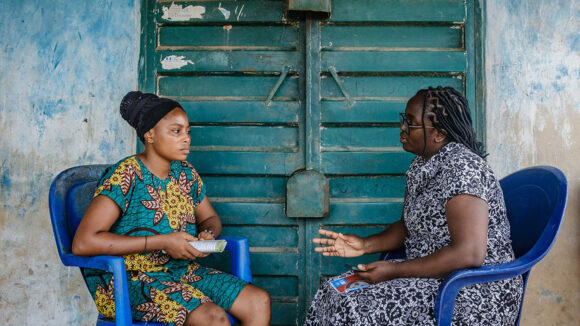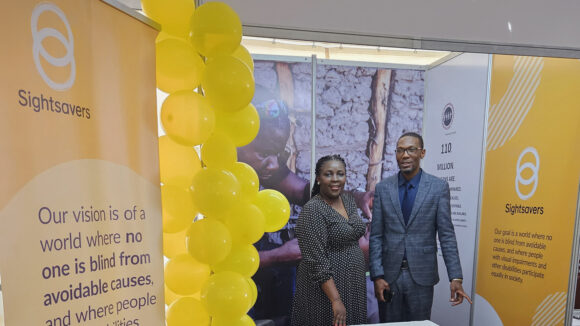NOTE: This article is more than five years old, but may still be relevant. For more recent content, see our news and blogs page.

To mark the 60th Commission on the Status of Women at the UN, Sightsavers presents a series of blogs on the importance of highlighting gender and disability. This introductory blog is by Tracy Vaughan-Gough, Sightsavers’ global technical lead for social inclusion.
I’ve worked on women’s rights and gender equality for many years but until joining Sightsavers, the specific experiences of women with disabilities was not often a focus of my work. Why was this? It now seems that during that time, despite the strength of the women’s movement, women with disabilities were not visible.
Then, when I started working on disability rights I noticed that within the sector, gender differences were also not adequately addressed by mainstream organisations and appeared to be tackled only by a few strong women advocates.
I think that is now changing – helped firstly by the UNCRPD (United Nations Convention on the Rights of Persons with Disabilities), which highlights* the multiple discrimination experienced by women and girls with disabilities, and secondly by the consultative process that shaped the Sustainable Development Goals and brought to the fore the complexities of marginalisation. When we developed Sightsavers’ strategic framework on empowerment and inclusion, we had the opportunity to ensure that gender and disability was explicit across all of our work.
This was important to me, because as I learned more about the disproportionate burden of blindness on women, it became clear that gender was an important factor if we were to ensure equitable eye health programmes. For girls with disabilities, barriers to education are different to boys – how could we make sure we addressed this?
Social inclusion
Sightsavers works with Disabled People’s Organisations (DPOs), but more needs to be done to ensure that women are equally represented and participating actively in decision-making. Our social inclusion strategy has a specific cross-cutting objective to promote gender equality, and we are committed to ensuring that all programming in the future is gender-responsive as well as disability-inclusive.
It’s challenging to mainstream gender. While always seeking innovative approaches at Sightsavers we rely on tried and tested interventions like capacity building, sensitisation and advocacy, as well as developing project design tools and accountability mechanisms:
Our eye health projects should now have strategies in place to screen and treat more women than men to achieve gender equity (greater examination of sex-disaggregated data will help us test whether these strategies are working).
We are specifically designing and evaluating our projects with gender in mind. We’re also building internal capacity, raising awareness and enabling staff to think about gender as central to their roles.
Even this gender-related series of blogs I’m now introducing is an idea that came out of a recent gender training session for staff!
One of the principles underpinning our social inclusion projects is participatory planning, implementation and evaluation. We support men and women with disabilities claim the rights that they are entitled to, but we recognise that in many of the countries in which we work, the voices and meaningful participation of women with disabilities remains subject to context-specific gender norms.
For that reason it is particularly important to make sure that as children, girls with disabilities have equitable access to education. It’s also important that women with disabilities are supported to obtain the skills they may lack due to inequitable access to education or health – skills to assist them in generating a livelihood, or obtaining a job, or taking a leadership role in their local council or women’s group. We want to learn how to do this better, through reflecting on our own experiences as well as benefiting from the knowledge and expertise of others.
The priority theme of this year’s CSW is ‘Women’s empowerment and its link to sustainable development’. I believe the work Sightsavers is doing will contribute to this, because when women receive life-enhancing services such as cataract surgeries and trachoma treatments equitably, they are more able to contribute socially and economically to their families’ and communities’ development.
*Article 6 – Women with disabilities 1. States Parties recognize that women and girls with disabilities are subject to multiple discrimination, and in this regard shall take measures to ensure the full and equal enjoyment by them of all human rights and fundamental freedoms. 2. States Parties shall take all appropriate measures to ensure the full development, advancement and empowerment of women, for the purpose of guaranteeing them the exercise and enjoyment of the human rights and fundamental freedoms set out in the present Convention.
By Tracy Vaughan-Gough, Sightsavers’ global technical lead for social inclusion
“For girls with disabilities, barriers to education are different to boys”
Want to read more about our work?
Sightsavers and disability rights
Why community collaboration is important in our research
Our research on female genital schistosomiasis has highlighted the need to establish a safe and supportive environment for participants when studying sensitive topics.

The key to inclusive education is engaging organisations of people with disabilities
Collaborating with organisations of people with disabilities (OPDs) on our inclusive education projects has earned the Sightsavers-led Inclusive Futures consortium a Zero Project Award in 2024.

Six takeaways from the International Conference for Public Health in Africa
Sightsavers’ Hortance Manjo shares insights from the event in Zambia, which highlighted eye health for the first time.